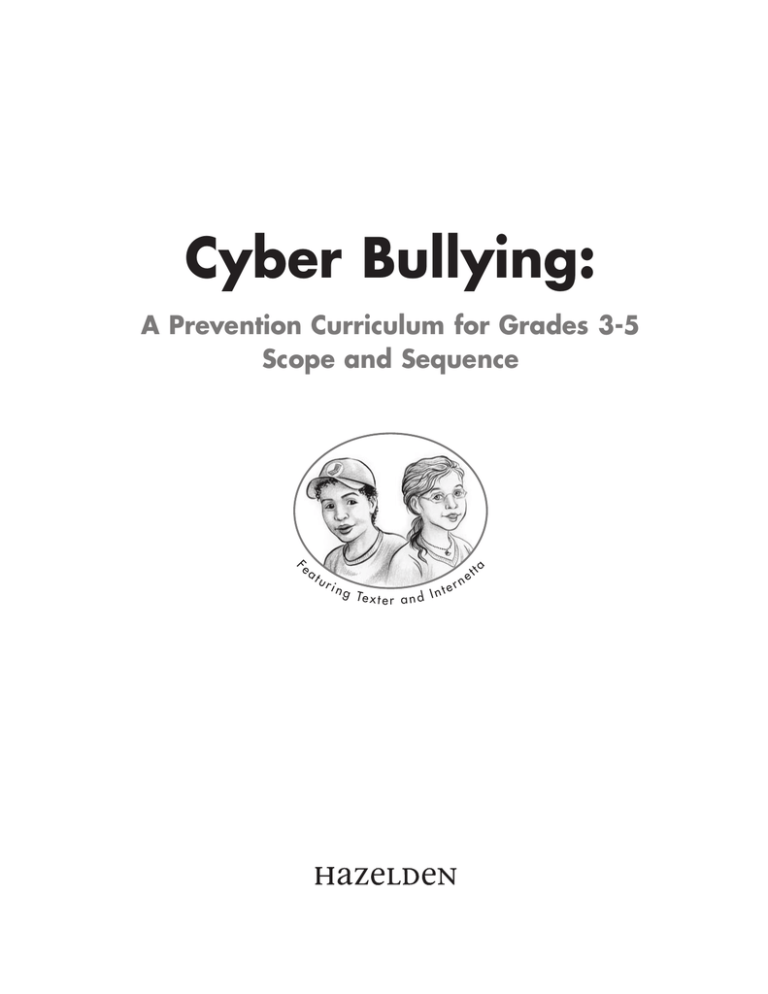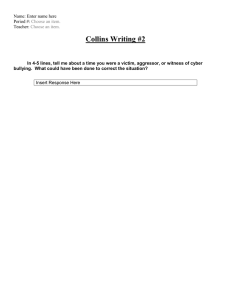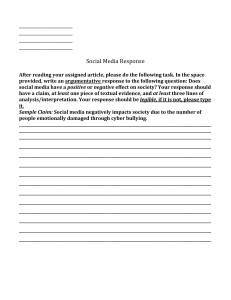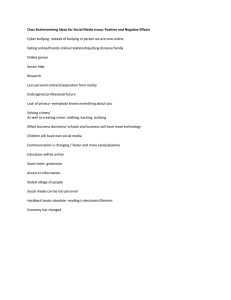
Cyber Bullying:
A Prevention Curriculum for Grades 3-5
Scope and Sequence
tu
t
a
F
ea
rin
g Te
xter and In
n
ter
et
Cyber Bullying:
A Prevention Curriculum for Grades 3 - 5
What is Cyber Bullying: A Prevention Curriculum for Grades 3-5?
Cyber Bullying: A Prevention Curriculum for Grades 3-5 is a program that addresses
the attitudes and behaviors associated with cyber bullying. The materials consist of a
five-session curriculum, along with additional resources on a CD-ROM, including the
following:
• Reproducible parent and guardian resources
• Program posters and student handouts
• Resources to address cyber bullying schoolwide (how to establish a school policy,
address legal concerns, and more)
• A short training on cyber bullying for program facilitators
Most of the materials needed to implement the program are included in the manual
and on the CD-ROM. In addition, a Web site has been established that will provide
up-to-date information about cyber bullying. This web site can be accessed at
www.hazelden.org/cyberbullying.
What Are the Goals of the Program?
This program strives to
• raise students’ and parents’ awareness of what cyber bullying is and why it is so
harmful.
• equip students with the skills and resources to treat each other respectfully when
they use cyber technologies.
• give students information about how to get help if they, or others they know, are
being cyber bullied.
• teach students how to use cyber technologies in positive ways.
For more information on the learner outcomes for each session, refer to the curriculum’s Scope and Sequence chart toward the end of this document.
Who is the Intended Audience?
Cyber Bullying: A Prevention Curriculum for Grades 3-5 is designed for upper elementary
school students. This program will fit well within a health education, communications,
technology, or general life skills curriculum (see references to national academic standards
For more information or to order, visit www.hazelden.org/cyberbullying or call Hazelden toll-free at 1-800-328-9000.
© 2008 by Hazelden Foundation. All rights reserved. Duplicating this material for personal or group use is permissible.
2/10
Cyber Bullying Scope and Sequence for Grades 3-5
at the end of this document). Teachers may use their discretion to adapt some activities
to the age and maturity level of their students.
The curriculum is most effectively used as part of a broader, ongoing bullying
prevention program, such as with Hazelden’s Olweus Bullying Prevention Program, or
as part of a general violence prevention effort.
A school counselor can offer Cyber Bullying as part of a support group, counseling, or
education program, or it can also be used in after-school, community, youth enrichment
(such as YMCA or Scouts), and faith-based youth programs.
Is This a Research-Based Program?
Cyber Bullying is not a research-based program, but it is based on the latest research in
the field of prevention and the topic of cyber bullying. Many of the lesson activities are
patterned after prevention models that research has shown to be effective in decreasing
negative student behaviors, while increasing student attitudes toward refraining from
negative behaviors.
The strategies to achieve these objectives include providing parent/guardian-student
activities, doing cooperative learning or project activities, and identifying the causes of
why students behave as they do.
The curriculum also recommends that schoolwide policies and procedures be established to effectively address the issue of cyber bullying in a broad way, while creating an
environment that is conducive to positive interactions among students. Research-based
programs, such as the Olweus Bullying Prevention Program, have proven that schoolwide
efforts are more effective in addressing bullying than classroom components alone.
Cyber Bullying: A Prevention Curriculum for Grades 3-5 Main Components
Five-session Curriculum
This curriculum consists of five, forty-minute classroom sessions, each of which is
intended to be taught weekly. Each session includes Student Learner Outcomes and
Parent/Guardian Learner Outcomes. A typical session begins with a story about two
upper elementary school students, Texter (he is a text messaging expert) and Internetta
(she is internet savvy). The two characters serve as role models as they share their
experiences in helping their friends deal with cyber issues, including cyber bullying.
After each session’s story has been read aloud, the teacher will lead the students in a
For more information or to order, visit www.hazelden.org/cyberbullying or call Hazelden toll-free at 1-800-328-9000.
© 2008 by Hazelden Foundation. All rights reserved. Duplicating this material for personal or group use is permissible.
3/10
Cyber Bullying Scope and Sequence for Grades 3-5
large group discussion that may include a transparency, LCD projection, or a poster.
The second part of each session involves an activity or game that integrates the content
of the story and discussion. You may wish to provide extra time for students to work on
some of these activities.
Parent/Guardian Materials
As with every strong prevention effort, it’s important to actively involve your students’
parents or guardians when implementing this program. The curriculum includes a parent/
guardian letter that informs parents and guardians about Cyber Bullying: A Prevention
Curriculum for Grades 3-5. It is recommended that this letter be sent to parents or
guardians prior to implementing the program, along with the Glossary of Cyber Terms
and Internet Safety Tips for Parents and Guardians, which are also included in the
curriculum.
Each session includes a homework assignment that students should do with a parent
or guardian. (This activity will help to achieve the Parent/Guardian Learner Outcomes.)
If a parent or guardian is unable to do the assignment with the student, another close
adult, such as a relative, neighbor, or caregiver, can complete it with him or her. The homework includes important information for parents and guardians about cyber bullying and
Internet safety. There are two activities for students and adults to do together, including
making family Internet safety rules and knowing what to do if cyber bullying occurs.
Each homework assignment includes a return slip for parents or guardians and students
to complete and sign. Students will bring the return slip to school so that the teacher
knows the homework was completed.
All parent and guardian materials are provided in both English and Spanish.
Teacher Training Outline
You may wish to train others to use Cyber Bullying. An outline for three-hour training is
provided with the curriculum.
Teacher Training Presentation
Included on the CD-ROM is a training presentation that includes in-depth information
and statistics on cyber bullying for teachers. This training can be used as either a self-led
training, or as part of the Teacher Training Outline.
For more information or to order, visit www.hazelden.org/cyberbullying or call Hazelden toll-free at 1-800-328-9000.
© 2008 by Hazelden Foundation. All rights reserved. Duplicating this material for personal or group use is permissible.
4/10
Cyber Bullying Scope and Sequence for Grades 3-5
Why is it Important to Teach about Cyber Bullying?
As young people become more computer and Internet savvy, instances of cyber bullying
have increased. Cyber bullying can have devastating effects on young people, including
clinical depression and suicide. It is therefore important to know just what cyber
bullying is.
What is cyber bullying?
Cyber bullying is bullying through email, instant messaging, in a chat room, on a Web site,
or through digital messages or images that are sent to a cellular phone or personal digital
assistant (PDA) (Kowalski et al., 2008). Cyber bullying, like traditional bullying, involves
a negative action that is often repeated, and involves an imbalance of power.
In traditional forms of bullying, an individual may have more power over another by
being bigger, stronger, or more popular. In cases of cyber bullying, however, an individual
may have more power simply by being able to instantly share negative comments or
photographs with a multitude of people via email, instant messaging, text messaging, or
through Web site posts. Cyber bullying may also involve several individuals targeting one
individual, or a more popular student targeting a less popular classmate.
An individual committing mean or negative actions repeatedly over a certain amount
of time also defines traditional bullying. When someone is cyber bullied, this repetition
of negative behavior can occur when another individual sends one embarrassing photo or
one degrading email message, which may consequently be forwarded to an entire class
or grade level. The perpetrator, who is usually known in a traditional bullying situation,
might go unidentified in the case of cyber bullying.
Moreover, traditional bullying usually occurs in a certain time and space, perhaps
during school in the bathrooms or the hallways. Students who are bullied can usually find
some relief at home or away from school. When a student is cyber bullied, the incident can
happen whenever someone turns on his or her computer, accesses the Internet, or uses
his or her cell phone. This often happens at home at any time of the day or night.
Cyber bullying poses unique challenges because it frequently happens outside of the
school setting, and thus may be difficult for educators to observe. In addition, students
may feel invisible or anonymous while accessing the Internet, which may lead to a
student’s greater willingness to engage in negative actions. Finally, without face-to-face
interaction, students who cyber bully have no opportunity to witness the emotional distress
that their comments may inflict on a peer.
For more information or to order, visit www.hazelden.org/cyberbullying or call Hazelden toll-free at 1-800-328-9000.
© 2008 by Hazelden Foundation. All rights reserved. Duplicating this material for personal or group use is permissible.
5/10
Cyber Bullying Scope and Sequence for Grades 3-5
There is a bright spot, however. While direct evidence may be hard to obtain in many
traditional forms of bullying, cyber bullying typically involves a form of communication
that can be saved and printed from a computer or saved on a cell phone. Such obvious
evidence can be helpful when addressing cyber bullying incidents.
Why should schools address the issue of cyber bullying?
Schools have rapidly embraced technology that offers advanced learning opportunities
and resources to students. Teachers use blogs, students post assignments online, and some
schools issue laptops and PDAs to students as instructional tools. By embracing technology
and encouraging students to explore its various forms, educators also have a responsibility
to teach students to use these forms of technology in a responsible manner.
In addition, many schools are adopting comprehensive bullying prevention programs,
such as the Olweus Bullying Prevention Program, or are at least teaching classroom lessons
that deal with bullying behaviors. Cyber bullying is one form of bullying that should be
specifically addressed as part of these comprehensive efforts.
Research has shown that not all students perceive cyber bullying as a form of bullying
behavior (Kowalski et al., 2008). Therefore, classroom lessons and discussions that focus
directly on cyber bullying are critical to preventing it from flourishing.
For more information or to order, visit www.hazelden.org/cyberbullying or call Hazelden toll-free at 1-800-328-9000.
© 2008 by Hazelden Foundation. All rights reserved. Duplicating this material for personal or group use is permissible.
6/10
Cyber Bullying Scope and Sequence for Grades 3-5
Curriculum Scope & Sequence
By the end of each session,
students will be able to
Session 1:
What Is Bullying?
Session 2:
What Is Cyber Bullying?
• define bullying.
By completing the homework
assignments with their child,
parents/guardians will be able to
• identify examples of bullying.
• describe the definition of bullying
and why it’s different from playful
teasing.
• identify some of the roles students
play in the “Bullying Circle.”
• explain how prevalent bullying is.
• identify rules to prevent bullying.
• know why it’s important to intervene,
and how to do that.
• define cyber bullying.
• explain the definition of cyber bullying.
• identify examples of cyber bullying.
• list the different technologies that their
kids will eventually be using.
• understand the importance of not
sharing passwords.
• show their child how important it is
that only they and their child know their
child’s password. (Internet Safety)
• explain how prevalent and serious
cyber bullying can become.
Session 3:
How Does Cyber Bullying
Affect People?
• identify the effects of cyber
bullying.
• empathize with people who are
cyber bullied.
• know that though cyber bullying can
happen outside of school, it does have
ramifications in school.
• explain the social and emotional harm
cyber bullying can inflict.
• describe what some of the academic
consequences of cyber bullying can be.
• know that they have control over their
child’s online activities.
Session 4:
How Do I Treat People Well
When I Use Technology?
Session 5:
What Do I Do if Someone
is Mean to Me
through Technology?
• define what “netiquette” is.
• identify basic rules of netiquette
for online communication.
• know basic online courtesy, or
“netiquette.”
• know how important family rules are
regarding use of the Internet, cell phones,
cameras, and Instant Messaging.
• identify possible responses to cyber
bullying situations.
• know what their options are if their child
is cyber bullied, both in and out of school.
• know that part of being safe online
means telling an adult if they experience cyber bullying.
• describe what they can do if their child’s
friend is cyber bullied.
• know that telling an adult about
being cyber bullied, or about someone they know who is being cyber
bullied, is not “tattling.”
• explain how doing the cyber bullying and
being cyber bullied can affect their child’s
online reputation.
• describe how research shows that kids
might not tell about cyber bullying for
fear of losing their cell phone and Internet
privileges. Know not to make that a
consequence.
For more information or to order, visit www.hazelden.org/cyberbullying or call Hazelden toll-free at 1-800-328-9000.
© 2008 by Hazelden Foundation. All rights reserved. Duplicating this material for personal or group use is permissible.
7/10
Cyber Bullying Scope and Sequence for Grades 3-5
Related National Academic Standards
Using Cyber Bullying: A Prevention Curriculum for Grades 3-5 will help you meet the
following national academic standards:
Health Education Standards 1
Students in grades 3 through 5 will
• identify how peers can influence healthy and unhealthy behaviors.
• explain how the media can influence their thoughts, feelings, and behaviors.
• describe ways that technology can affect their personal health.
• demonstrate effective verbal and nonverbal communication skills to enhance
their personal health.
• demonstrate refusal skills that help them avoid or reduce health risks.
• demonstrate how to ask for assistance that will enhance their personal health.
• demonstrate a variety of behaviors that will help them avoid or reduce health risks.
• encourage others to make positive health choices.
Technology Education Standards 2
Communication and Collaboration
Students in grades 3 through 5 will
• interact, collaborate, and publish with peers, experts, or others while using a
variety of digital environments and media.
• communicate information and ideas effectively to multiple audiences while using
a variety of digital media and formats.
• contribute to project teams to produce original works or solve problems.
1. Joint Committee on National Health Education Standards. National Health Education Standards, Second Edition,
Achieving Excellence. The American Cancer Society. 2007.
2. National Educational Technology Standards for Students, Second Edition, © 2007, ISTE® (International Society
for Technology in Education), www.iste.org. All rights reserved.
For more information or to order, visit www.hazelden.org/cyberbullying or call Hazelden toll-free at 1-800-328-9000.
© 2008 by Hazelden Foundation. All rights reserved. Duplicating this material for personal or group use is permissible.
8/10
Cyber Bullying Scope and Sequence for Grades 3-5
Critical Thinking, Problem Solving, and Decision Making
Students in Grades 3 through 5 will
• identify and define authentic problems and significant questions for investigation.
• plan and manage activities to develop a solution to an issue or complete a project.
• collect and analyze data to identify solutions to issues and make informed decisions.
• use multiple processes and diverse perspectives to explore alternative solutions.
Digital Citizenship
Students in grades 3 through 5 will
• Advocate and practice safe, legal, and responsible use of information and technology.
• exhibit a positive attitude toward using technology that supports collaboration,
learning, and productivity.
• demonstrate personal responsibility for lifelong learning.
• exhibit leadership for digital citizenship.
For more information or to order, visit www.hazelden.org/cyberbullying or call Hazelden toll-free at 1-800-328-9000.
© 2008 by Hazelden Foundation. All rights reserved. Duplicating this material for personal or group use is permissible.
9/10




